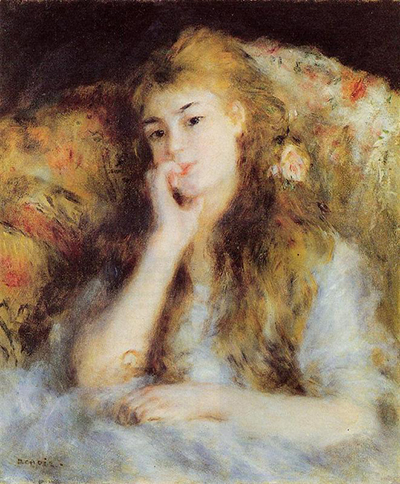Pierre-Auguste Renoir (1841 to 1919) was one of the pioneers of the Impressionist style of painting. “The Thinker,” also known as “Young Woman Seated,” was painted in 1876 or 1877, when Renoir was at the peak of his powers
It depicts a young woman in a pensive mode, with a hand on her lower face, the palm on her chin, and one of her fingers in her mouth.
The theme bears a striking similarity to Auguste Rodin's famous bronze sculpture of the same name, with the difference being Renoir's painting depicting a more realistic everyday scene of an ordinary person, in a similar pose.
Early in his career, Renoir digressed with the overbearing contemporary style of depicting the world in an idealised light, something which Rodin's "Thinker" statue also did.
There are countless related artworks from other famous names that tackle individual behaviours or emotions, way beyond just the impressionists. Albrecht Durer gave us Melancholia, and many centuries later Edvard Munch gave us a whole series which included The Scream, Despair and Anxiety.
Rodin was inspired by style and subject matter of his contemporary doyens, such as Edouard Manet and Camille Pissarro, and soon struck up a powerful association with them.
Impressionism as an art movement tries to depict the subject matter with a high degree of accuracy. The chief features of a typical impressionist painting are unusual visual angles, prominence to human movements as a key element of perception, and an accurate depiction of light.
The painting is often done in relatively thin and small, yet highly visible brush strokes. True to form, Renoir's “The Thinker” has all these characteristics. It depicts a sanguine feminine figure, with a highly realistic expression one would normally encounter in everyday life.
However, by 1877, Renoir digressed from the impressionist group, and developed his unique signature style. Unlike his contemporary Monet and other impressionists who focused on landscapes, Renoir focused on depicting occurrences of everyday life, and made liberal use of human portraiture.
He is also known for his extensive use of vibrant colours and mastery of light. Another noteworthy trait of his paintings is the complex composition executed with great care.
"The Thinker" features almost all of Renoir’s characteristic traits, and marks the time when he digressed from the classic impressionism into his own distinctive style. Renoir, always known to celebrate feminine beauty and sensuality, does not disappoint in "The Thinker" either.
The young and beautiful, yet innocent face occupying the overriding portion of the canvas has a charm of its own. However, while unlike the case of most of his painting, where Renoir celebrated the sensuous female figure in the nude, here Renoir focuses on the face, and the women is clothed in white, and also an expensive fur coat.
The original work of “The Thinker,” a portrait made in oil and canvas is now in private collection.




